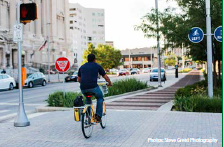ROAD DIETS LEAD TO ECONOMIC DEVELOPMENT
| Objective | Features | Results |
|---|---|---|
|
|
|

The City of Indianapolis, through a public-private partnership, completed the Indianapolis Cultural Trail, an 8-mile biking and walking trail system that connects the cultural districts, neighborhoods, and the city's greenway system. In order to complete this trail system, streets in downtown Indianapolis underwent Road Diets.
The streets in downtown Indianapolis were mostly five or six lanes wide, and speeds could reach close to 50 mph. The design team reduced both the number of lanes and lane widths as a way of both slowing speeds and gaining extra space within the right of way to allow for the separate pedestrian and bicyclist trail. The completed trail loops around downtown and connects to greenways with two spurs. The trail includes shared space for bicyclists and pedestrians, and some areas incorporate two separate facilities for pedestrians and bicyclists.
 The ICT has brought a significant increase in pedestrian and bicycle traffic to downtown Indianapolis. |
 Pedestrian travel is separated from bicycle travel on this segment of ICT. |
 Riding the Pacers Bikeshare on the Cultural Trail. |
PUBLIC OUTREACH, PLANNING, AND DESIGN
Central Indiana Community Foundation (CICF) and the Mayor of Indianapolis envisioned that by providing improved multi-modal connectivity throughout Indianapolis' cultural districts and historic neighborhoods, economic development in the area would improve. Leaders of the proposed trail project spent years explaining the potential benefits to politicians, philanthropists, and community officials and collecting private donations.
Over $300 million of new development has been constructed along the route since 2008.
With the project consisting of seven phases and construction lasting almost 6 years, team members felt their commitment to public involvement and engagement throughout was a key component of the project's success. Early in the conceptual phase, the design team held a workshop to present the concept to the stakeholders. The team created a project website with up-to-date progress information and conducted many public meetings throughout the duration of the project.
Improving safety for all users was one of the project team's goals. In addition to the traffic calming effect the Road Diets provided, the design also included other safety features, such as curb bulb-outs at intersections to reduce crossing distance, chicanes in the bicycle facilities to alert bicyclists of an upcoming intersection, and countdown timers and audible pedestrian signals.
RESULTS
Although the last phase of the trail was not completed until the end of 2012, new construction and redevelopment started happening in the area well before the project was finished. Over $300 million of new development has been constructed along the route since 2008. While tax assessment data from 2007-2010 from nearby areas decreased by 1.2 percent, the assessed value along the Cultural Trail showed a small increase.
Using the Cultural Trail as its main marketing strategy, the visitor's bureau sees the trail's influence in downtown revitalization success. Vacant lots are being developed into restaurants and businesses. Local developers have opened several mixed-use, multi-family residential developments. This innovative redesign of the area has improved economic development and has brought a significant increase in pedestrian and bicycle traffic to downtown Indianapolis as people of all ages and abilities have embraced the trail.
Source: Pedestrian & Bicycle Information Center, "Indianapolis Cultural Trail," webpage. Accessed March 18, 2015. Available at: http://www.pedbikeinfo.org/data/library/details.cfm?id=4919
